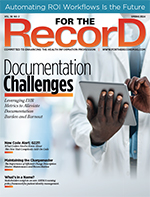Spring  2024 Issue
2024 Issue
Perspective on Automation: Automating ROI Workflows Is the Future. Is Your HI Team Prepared?
By Jami Woebkenberg, MHIM, RHIA, CPHI, FAHIMA
For The Record
Vol. 36 No. 2 P. 8
As health information teams face new workforce challenges, digitized departmental workflows become pertinent. Here’s how one health system met the challenges.
The fragility of our nation’s health system workforce is often exposed through gaps in staffing for back-end operational functions. One of these operational functions is medical record request or release of information (ROI) operations. Health information (HI) leaders face staffing shortages, manual processes, regulatory changes, dramatic volume spikes, and disparate storage locations to retrieve patient information. Each of these challenges is exacerbated by outdated manual processes that negate efficiency and compliance as priorities.
Recognizing these challenges, Banner Health undertook a strategic initiative in 2021 to introduce a KLAS-rated ROI partner and its technology into its HI and revenue cycle operational workflows. This article summarizes our experiences, lessons learned, and practical advice to move from manual processes to digitized operations for the ROI process.
The Backstory
Regarded and recognized as a top health system in the country for the clinical quality consistently provided to patients in our hospitals, nonprofit Banner Health is headquartered in Phoenix and operates 33 hospitals, including three academic medical centers and other related health entities and services in six states. Our centralized ROI team supports the release of medical records for our acute hospitals, urgent care, and ambulatory clinics and health centers.
The staff’s previous workflow relied on internally developed processes to organize and assign requests. To optimize our in-house ROI operation, leaders within HI, privacy, legal, IT, and compliance departments unanimously decided to outsource the hefty task of evolving legacy processes and implementing new automated technology.
The process we undertook, and outcomes achieved, further solidified compliance with existing HIPAA regulations and the new Cures Act requirements.
Modern Challenges Require Modern Solutions
In 2023, 63% of providers1 reported staffing shortages within their organizations’ revenue cycle management functions. This constant overload for back-end staff results in health systems reporting increased strain2 across many administrative areas such as scheduling, coding, billing, and registration. These teams affect patient experience, especially when delays or redundancies result in frustrated patient interactions across the health system.
Furthermore, these departments must incorporate new administrative requirements from governing bodies into their workflows. In fact, providers spend $39 billion3 a year to uphold such regulations.
New technology equipped to handle the latest compliance concerns, risk mitigation, support services, and vast volumes of requests was vital to the sustainability of our health system.
Results and Recommendations for Efficient Operations
We advocated for new ROI technology to integrate within our current systems. The project increased staff efficiencies, modernized processes, and ensured adherence to patient privacy and compliance standards.
Banner Health produced a 5% increase in staff and operational efficiencies, even adding supplemental workflows for support by ROI staff. In addition, we realized the following improvements:
• 38% decrease in call center volume;
• 83% decrease in call wait times;
• 33% decrease in average call lengths; and
• 60% decrease in request turnaround times.
Based on our finalized implementation results, the following are recommendations for hospitals and health systems looking to digitize their ROI processes:
• Adopt a forward-thinking mindset. Speak to all internal stakeholders for clarity on the current challenges facing your staff. Though ROI departments face their fair share of issues, the correct technology platform for your organization will offer solutions for capabilities needed in the future.
• Encourage staff. End users will typically express initial concerns or hesitations when introducing a new technology to their existing workflow. While the intent is to alleviate their workload, staff may have preconceived notions about automated ROI. This includes concerns with retaining their position and fear of the unknown.
• Instill confidence in your ROI staff that the platform is not intended to outsource their jobs but to prioritize their skill sets by modernizing the workflow. Communicate openly between end users, department leaders, executives, and technology partners to mitigate staff resistance. Transparency in communication helps build trust and rapport.
• Overall Impact: Recognizing the industrywide need for automation within the revenue cycle, we have benefited greatly from the results of implementing an innovative platform in ROI workflow. Leaders who are quick to resolve issues plaguing their health system must proactively address concerns that negatively impact staff and cash flow—staffing shortages, manual processes, regulatory compliance, and cybersecurity.
While change is often met with resistance and discomfort, it’s important for health care and provider organizations to adopt intelligent automated processes and implement such technology into HI and other revenue cycle administrative workflows. Streamlining our organization’s ROI bolstered proven success in our bottom line and patient satisfaction rankings.
— Jami Woebkenberg, MHIM, RHIA, CPHI, FAHIMA, is the senior director of HIM operations at Banner Health.
References
1. Synchrony. Study finds healthcare providers looking to outsource revenue cycle management processes. PR Newswire website. https://www.prnewswire.com/news-releases/study-finds-healthcare-providers-looking-to-outsource-revenue-cycle-management-processes-301791790.html. Published April 6, 2023.
2. Hagland M. Survey: CFOs, RCM VPs facing severe cost, staffing-shortage challenges. Healthcare Innovation website. https://www.hcinnovationgroup.com/finance-revenue-cycle/revenue-cycle-management/news/21272867/survey-cfos-rcm-vps-facing-severe-cost-staffing-shortage-challenges. Published June 30, 2022.
3. American Hospital Association. Regulatory overload: assessing the regulatory burden on health systems, hospitals and post-acute care providers. https://www.aha.org/system/files/2018-02/regulatory-overload-report.pdf. Published October 2017.



